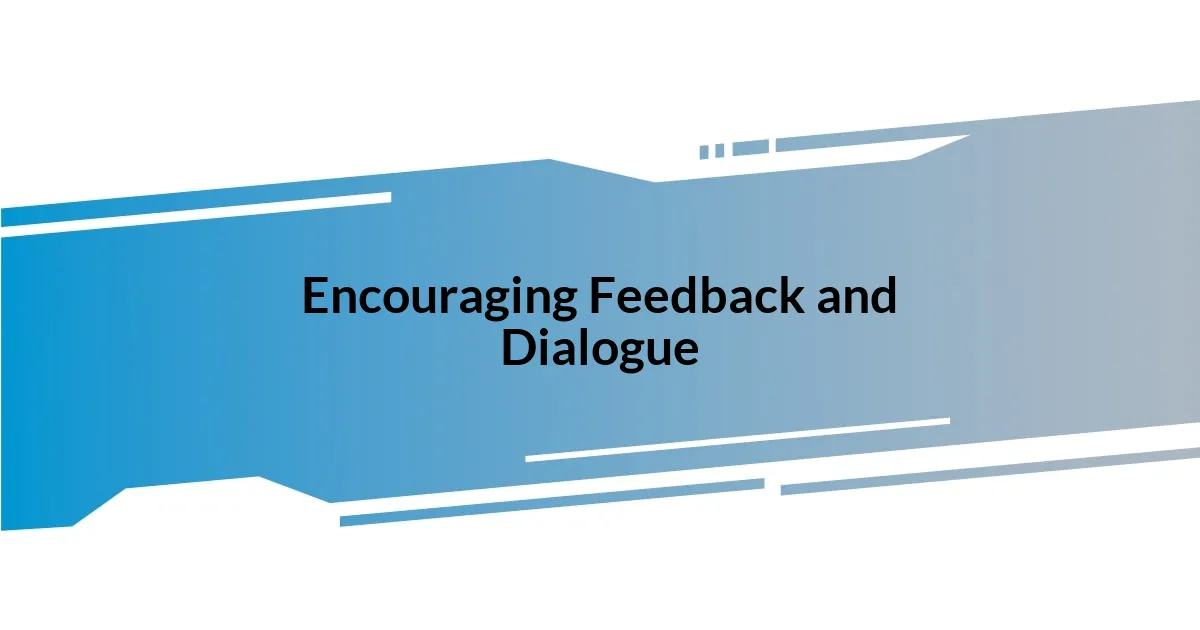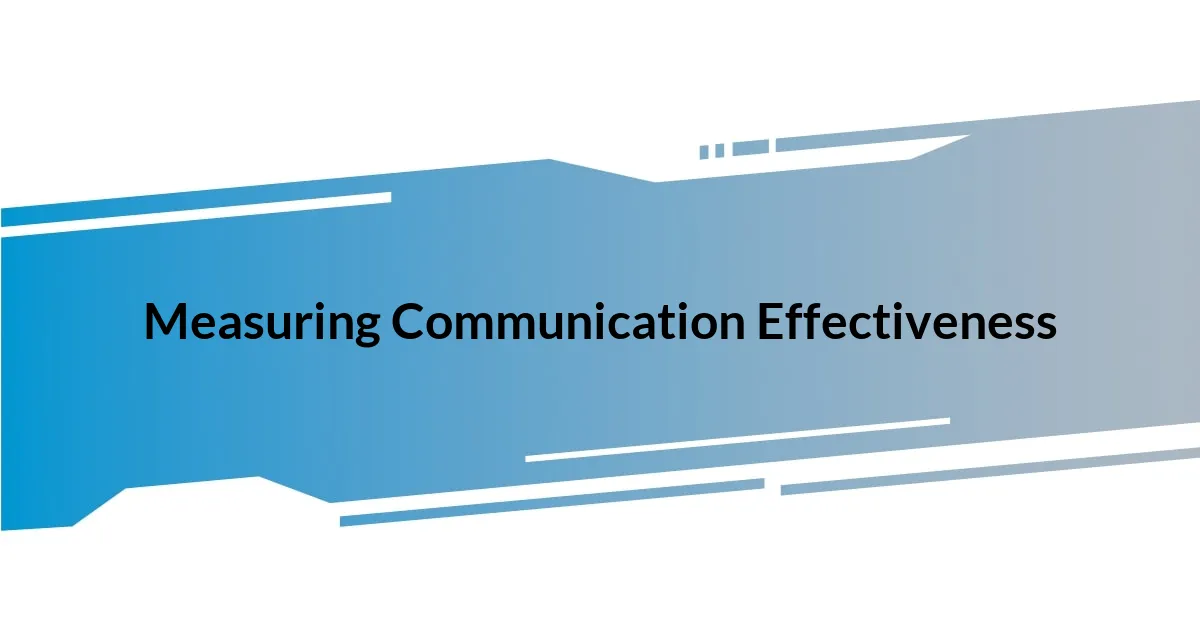Key takeaways:
- Open communication fosters trust, transparency, and collaboration, enhancing problem-solving and engagement within teams.
- Effective listening strategies, such as paraphrasing and maintaining eye contact, create an atmosphere of empathy and understanding.
- Utilizing technology like video calls and collaborative tools can amplify creativity and improve communication, especially in remote settings.
- Consistent follow-up and feedback mechanisms, such as surveys, help measure communication effectiveness and adapt strategies for better outcomes.

Understanding Open Communication Practices
Open communication practices revolve around the concept of transparency and trust. I vividly remember a time when my team leader had a candid conversation with us about a significant project setback. Her willingness to share the challenges rather than avoid them created a space where everyone felt comfortable sharing their thoughts. Isn’t it fascinating how vulnerability can actually strengthen a team?
Listening is just as crucial as speaking in open communication. I’ve learned from experience that sometimes, the best way to foster dialogue is to ask open-ended questions and genuinely listen to the responses. When I would initiate team meetings where everyone was encouraged to share ideas, I noticed that the discussions blossomed, and we generated creative solutions together. Have you ever noticed how conversations can shift when people feel their voices are truly valued?
Moreover, consistency in communication is key. There was a period in my previous job when weekly check-ins became a norm, and it felt reassuring. These regular touchpoints not only kept everyone informed but also provided a platform for minor issues to surface before they ballooned. How do you think regular communication can affect relationships, both in the workplace and in everyday life?

Importance of Open Communication
Open communication is fundamentally empowering. I’ve seen firsthand how it breaks down barriers and fosters a culture of collaboration. For instance, in a project I was part of, we faced some unexpected roadblocks. By openly discussing our challenges, we not only found solutions faster but also bolstered team cohesion. It was almost like watching trust bloom in real time.
Here are a few key reasons why open communication is vital:
- Builds Trust: When team members are transparent, it fosters a sense of trust and safety.
- Facilitates Problem-Solving: Open dialogue leads to quicker resolutions and more innovative solutions.
- Enhances Engagement: Team members who feel heard are more likely to be engaged and motivated.
- Promotes Accountability: When communication is clear, everyone knows their responsibilities and expectations.
- Strengthens Relationships: Open communication enhances personal connections, leading to a more harmonious work environment.
In my experience, witnessing team members express their thoughts freely transformed our work dynamic. The joy of bouncing ideas off one another was palpable, and I still remember the excitement of collaborating on solutions rather than facing them in isolation.

Strategies for Effective Listening
Listening is an art form that demands attention and intentionality. One powerful strategy I’ve embraced is paraphrasing what the other person has said. This not only shows that I’m engaged but also gives them a chance to clarify their thoughts if needed. I remember my friend sharing a personal struggle, and when I restated her feelings back to her, she felt truly heard. Have you ever experienced that moment of connection when someone captures your thoughts perfectly?
Another effective listening strategy is maintaining eye contact and using non-verbal cues to show interest. I’ve found that leaning slightly forward or nodding can encourage the speaker to share more openly. There was an instance during a difficult team discussion when I noticed how this small gesture prompted my colleagues to open up about their concerns. It is remarkable how these subtle signals can create an atmosphere of empathy and understanding, isn’t it?
Last but definitely not least, practicing patience is crucial. Often, people need time to organize their thoughts before expressing them. I once participated in a brainstorming session that felt lengthy and slow, but the outcome was a wealth of innovative ideas. It taught me that giving others the space to articulate their thoughts can lead to unexpected breakthroughs. Do you find that slowing down the pace of a conversation often yields richer insights?
| Strategy | Description |
|---|---|
| Paraphrasing | Restate what the speaker has said to confirm understanding and encourage clarification. |
| Non-Verbal Cues | Use eye contact and body language to show attentiveness, promoting openness in discussions. |
| Patience | Allow time for others to think and respond, enabling deeper and more thoughtful conversations. |

Encouraging Feedback and Dialogue
Encouraging feedback starts with creating a safe space where team members feel their opinions genuinely matter. I remember a time during a team meeting when I opened the floor to suggestions about an ongoing project. To my surprise, it sparked a lively exchange of ideas that revealed overlooked issues. How often do we miss out on valuable insights simply because we don’t ask for them?
To further foster dialogue, I always emphasize the importance of follow-up. After gathering feedback, I make it a point to share how that input has influenced decisions or changes. There’s something incredibly motivating about knowing your thoughts led to tangible outcomes. It reinforces the idea that each voice contributes to our collective progress.
Lastly, I’ve found that actively encouraging diverse perspectives enriches discussions. In a recent workshop, I invited quieter team members to share their thoughts, and it led to a depth of understanding about varying viewpoints. Have you noticed how different backgrounds and experiences can generate fresh ideas? It’s fascinating to see how diversity fuels creativity and problem-solving.

Utilizing Technology for Communication
Utilizing technology for communication has transformed the way I connect with others. I’ve found that platforms like Slack or Microsoft Teams can create channels dedicated to specific projects or topics. It’s remarkable how quickly a shared space can generate vibrant discussions that I might not have initiated face-to-face. Have you ever noticed how a message in a chat can sometimes spark an idea that leads to a breakthrough?
In my experience, video calls have become invaluable for fostering open communication, especially with remote teams. I remember a time when we faced a complex issue that seemed insurmountable through emails alone. Once we switched to a video call, conversations flowed more freely. Seeing each other’s faces allowed us to gauge reactions better and move past misunderstandings. It makes me wonder—doesn’t having that visual connection just elevate the interaction?
Moreover, I often utilize collaborative tools like Google Docs to encourage real-time input from everyone involved. There’s something powerful about seeing thoughts being written and edited in front of you, which creates a sense of ownership over the content. I recall a recent project when team members stayed up late, contributing ideas on a shared document. The excitement was palpable as we watched our thoughts evolve together. Isn’t it incredible how technology can amplify creativity and teamwork?

Building Trust in Communication
Building trust in communication is essential for fostering a collaborative environment. I remember when I first joined a new team. Initially, I felt hesitant to share my thoughts, but one colleague genuinely listened and acknowledged my contributions. That small gesture opened the door for me to feel safe in sharing more. Have you ever had a moment like that, where one person’s support changed your entire perspective?
Trust flourishes in communication when there is transparency. I’ve seen firsthand how being open about challenges, even failures, strengthens relationships. During a particularly tough project, I decided to share our team’s setbacks with everyone. Instead of facing criticism, we bonded over our struggles, leading to an open dialogue about solutions. Wasn’t it surprising how vulnerability can unite a group?
Lastly, consistency is key in building lasting trust. I make it a point to follow through on promises, whether it’s addressing concerns raised during meetings or simply being available to chat. I recall a time when a teammate reached out with a problem; I set aside time to help, and it not only resolved their issue but also solidified our working relationship. Doesn’t it feel good when you can rely on someone to be there when you need them?

Measuring Communication Effectiveness
Measuring the effectiveness of communication can often feel like navigating a maze. One method I’ve used is gathering feedback through surveys after team meetings. I still remember launching an anonymous survey after a particularly complex project discussion. The responses showed me that while some were engaged, others felt lost. Those insights were invaluable; they drove me to adapt my communication style to better meet the needs of my team. Isn’t it interesting how feedback can become a compass for improvement?
Another approach I’ve found effective is observing the dynamics in our discussions. I often pay attention to how many voices contribute in a meeting. I realized last year, during a brainstorming session, that one or two people often dominated the conversation. This insight prompted me to implement a more structured approach with round-robin sharing, which allowed everyone to have a say. How often do we overlook the quieter voices in our conversations?
Lastly, analyzing outcomes can tell us a lot about our communication effectiveness. For instance, I once tracked project success rates before and after implementing weekly check-ins. The increase in team productivity was evident. It made me ponder—when we adjust how we communicate, can it really lead to tangible results? Through this process, I’ve learned that measuring effectiveness is not just about what we say, but how our communication influences our work and relationships.